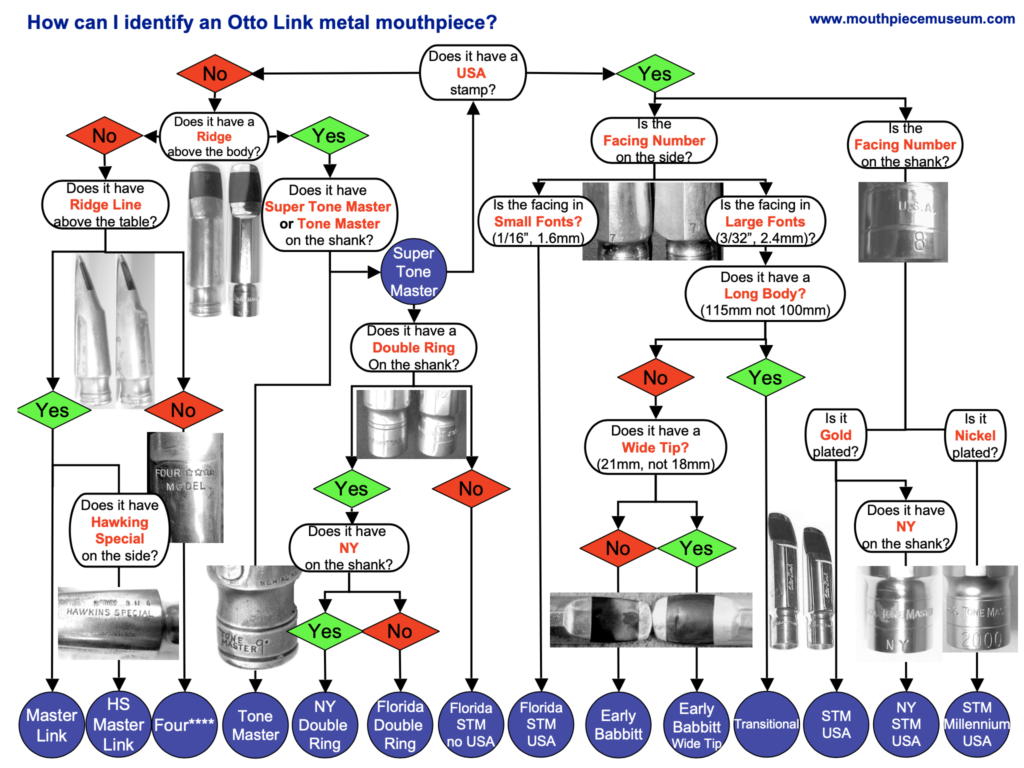This Otto Link Metal Mouthpiece guide shows you which version your Otto Link metal saxophone mouthpiece is. Many people wonder whether they have a Florida Otto Link Super Tone Master, or whether their Otto Link is an Early Babbitt or not. This Otto Link mouthpiece guide was made a long time ago, and the website that posted it is gone, so I’m posting it here for easy reference. The flow chart format is great because it shows you how to distinguish each set of similar mouthpiece models based on a telltale feature. This will help you to buy intelligently, and not buy a modern Link thinking it’s a more valuable Florida or New York model. If you still have questions, post them in the comments, and I’ll answer them.
Value wise, generally speaking, a Florida Otto Link is going to be worth 2-3x what a current production modern Babbitt-made piece will be worth. This is mainly because they were made better and had way more hand baffle work and better facings in Florida. You might also be wondering whether the different versions of Otto Link mouthpieces sound different from each other. The answer is a resounding YES. The general trend is from very dark to rather bright moving from left to right along this flow chart bottom row. However, the Early Babbitt in both its forms is probably the brightest of all, particularly if you get one that has a high ‘step’ baffle configuration. (The baffle is about the first 1/2″ (~1cm) of the floor of the mouthpiece just inside the tip rail going into the chamber.) Modern Link Super Tone Masters like you would buy on Amazon are both kind of brash and bright, and also kind of unfocused. The facings are also frequently both irregular and too long, which makes them play kind of dead and also only want to respond when you push a lot of air through, but not at low volumes. That can be really frustrating. It’s no wonder that people tend to look for an earlier, better made one, or get a modern one expertly refaced to fix the factory problems that they often have.
Confusingly, since this chart was made, Babbitt came out with an Otto Link 100th Anniversary ‘Florida’ model, which, oddly enough, is NOT a casting based on an actual Florida Otto Link, but rather is more like a modern Link, but is ‘Florida-ish’. I bought a handful of those new when they came out, and they all needed significant refacing work in order to make the facing even and to make the all-important baffle area look like a real Florida Otto Link. That done, they can play quite well. You can identify the modern “FL” 100th anniversary model just like the NY STM USA second from right. There is also a modern Tone Master reissue that has USA on the shank and a four digit serial to the right of the table.

And by popular request, here’s a comparison of different Otto Link Tone Master versions (so this breaks down the fourth from left blue dot above). They are difficult to tell apart. The baffle is higher on the ‘improved’ version, and the letter stamp in the ‘improved’ tends to be a much larger font size. You can’t tell them apart from the second version by the shank style as far as I know. I’ll update this if I discover salient ID aids that you can do from photos rather than looking at the baffle and overall mouthpiece design in person. Hank Mobley used a Tone Master Improved on Soul Station by the way. 
Tone Master Improved is also on the right below. See how the baffle isn’t scooped out about 5mm from the tip rail on the Improved? That is hard to see if you’re buying from pictures though. And if you are buying a refaced ToneMaster Improved, it might still look a little scooped if it has been opened up significantly at the tip. 

Does the Otto Link flowchart apply to baritone mouthpieces?
It’s helpful but not exactly accurate. The general trends are the same.
Here is a question:
I have an STM Otto Link that does not look or play like my others.
The color is different, much darker gold, and Super does not have quotation marks on it.
It also seems a tad thicker than the other STMs, and my Selmer ligature doesn’t fit on it.
Seems to have a fatter sound.
Otherwise, everything else tells me it should be standard STM.
Thoughts?
There have been several variations of modern Link, including some FL-inspired (or at least marketed) pieces, and some NY-inspired as well. Does yours have any unusual stamping? There’s also some variability from piece to piece in the way the baffle is done, and in the evenness of the facing (which can affect how it feels to play. Maybe some photos would help.